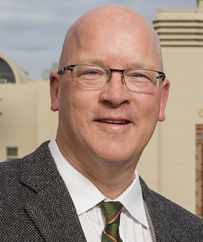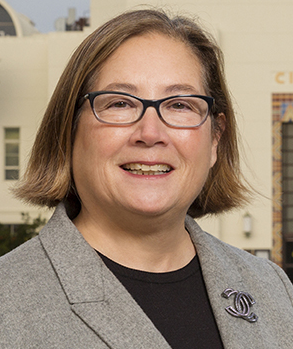The city of Santa Monica is known throughout Southern California for the vocal community participation and faithful implementation if its city plans—as well as its extremely cautious approach to new development. For TPR, Mayor Ted Winterer and Mayor pro Tem Gleam Davis comment on the attempts in the new Downtown Community Plan—including a bold inclusionary housing rule—to balance the priorities of accommodating new growth, improving housing affordability, and preserving the feel of the small city.

Ted Winterer
"Unlike many neighboring cities, we have produced clear development standards throughout the city, with options for height and FAR in return for community benefits and additional affordable housing, and with an emphasis on new building along transit corridors. So while we may have set the price of entry high for new development in our city, we also offer a clear and certain path to entitlements." —Mayor Ted Winterer
Santa Monica’s newly approved Downtown Community Plan culminates a six-year planning effort, during which controversies over several high-profile projects—as well as an initiative requiring public votes on most developments over two stories—seemed to overshadow the city’s effort to plan for the future. Yet at the end, despite disagreement about inclusionary housing ratios, the plan passed the Planning Commission 6-1 and the Council 7-0. Are we seeing a new consensus in Santa Monica, with what City Manager Rick Cole called “a grand bargain” that eliminated parking minimums, streamlined housing approvals, and increased the amount of affordable housing in market-rate projects?
Ted Winterer: Certainly, there is consensus among the members of the Planning Commission and the other advisory commissions that reviewed and approved the Downtown Community Plan. However, during our extensive public outreach, we continued to hear both from those who are opposed to more development in our city and those who believe we should build higher, denser, and faster to address the regional housing shortage and to reduce our carbon footprint.
That said, there’s a significant, though less vocal, centrist voice. These residents acknowledge that our downtown, though a mere 4.5 percent of our land area, is the economic engine that pays for city services. They also see Downtown, due to its location adjacent to the Expo Line, as the ideal place to build more housing, while maintaining its scale and history. So between these polarized viewpoints, we’ve practiced the art of the possible.
Gleam Davis: Although I would like to think that the community is less polarized than it has been, I think the jury is still out on that question. I anticipate that, as each of the three established large site projects comes to Planning Commission and the City Council for consideration, there will be vocal support for, and opposition to, each one. I do hope that the community sees that many of the ideas included in the Downtown Community Plan are intended to address perennial issues, such as traffic and parking. If we have consensus on that, we have achieved a great deal.
Santa Monica has long been viewed as being on the cutting edge of urban planning as well as social and environmental policy innovation. LA Times critic Christopher Hawthorne has embraced the possibility that the new approach Santa Monica took with the Downtown Community Plan might be a model for the region.
Is Santa Monica leading the way once again on urban community planning?
Gleam Davis: I hope so. Our decision to eliminate minimum parking requirements and establish a truly multi-modal and safe downtown can demonstrate that, while not everyone will give up their cars, we can create meaningful options that reduce congestion in our core Downtown area and make our streets safer for everyone.
Ted Winterer: Unlike many neighboring cities, we have produced clear development standards throughout the city, with options for height and FAR in return for community benefits and additional affordable housing, and with an emphasis on new building along transit corridors. So while we may have set the price of entry high for new development in our city, we also offer a clear and certain path to entitlements.
The two of you took opposite sides in the split vote over whether to adopt what may be California’s highest ratio of inclusionary housing—up to 30 percent in projects that are six stories or more. Since both of you are strong supporters of affordable housing, what do each of you think are the prospects for Santa Monica achieving these high levels of inclusionary housing?
Ted Winterer: I’m sanguine we will see projects seek to comply with the new affordability standards. The feasibility analysis on which we relied used relatively low estimates of future income potential for housing at a time when demand is driving rents higher much faster than the rate of inflation. The analysis also included the cost of providing parking, which, of course, we’ve eliminated, and the administrative approval process saves applicants time and money.
Every time we’ve levied new costs and demands on future development, whether through a Transportation Impact Fee or water-use neutrality requirements, we’ve been told that new projects won’t be able to absorb those burdens. Yet the applications keep rolling across the transom at City Hall.
In addition, of the 2,500 housing units allowed in the DCP EIR, more than 1,000 are already entitled through development agreements with negotiated inclusionary standards. And in a compromise forged by the Council at our last hearing on the Downtown plan, applications for another 680 units were allowed to seek administrative approval if they provided 20 percent inclusionary housing. Thus, the EIR may only allow another 700-800 units to be built in the next 13 years with the higher inclusionary requirements. While it may take some time for land values to adjust accordingly, I believe high demand for housing and a limited opportunity to build will yield projects which meet the more ambitious standards.
Is there a risk we’ve aimed too high? Sure—but given the rapid erosion of socioeconomic diversity in our city, and the dire need for affordable housing, it’s a risk I’m prepared to take.
Gleam Davis: I am worried that we may have missed the mark with the high inclusionary levels. I hope I am wrong on that.
On the day we adopted our requirements, San Francisco reduced its inclusionary requirements for many projects from 25 to 18 percent because, at the 25 percent level, the city was not seeing any new housing development. I received many phone calls, not just from developers, but also from many affordable housing advocates across the state, warning that setting inclusionary requirements too high will discourage housing projects. That is why I requested updates every six months on housing developments in the Downtown area.
If we adopt this plan that supposedly reduces constraints on housing, and we don’t see a flood of housing being proposed or built in the next six months to a year, I hope we can be humble enough to realize we overshot the mark and make necessary adjustments to the inclusionary levels. If, on the other hand, we see lots of housing being proposed and built, no one will be happier than me.
Despite launching the region’s first bike-share program, which recently racked up its millionth ridership mile, and a new push for the Vision Zero initiative to eliminating traffic deaths, traffic is still a hot issue for Santa Monica. What impact has the Metro Expo Line extension had in its first year, especially in context of the city’s bold goal of creating “a new model of mobility”? Is the city making measurable progress toward more balanced transportation options?
Gleam Davis: The Expo is a huge benefit to our community. The outstanding ridership numbers that have been achieved in a little over a year demonstrate people’s willingness to get out of their cars and onto transit.
We need to build on this success by creating better connections within Santa Monica. I am especially committed to our Vision Zero goals, as I believe that if people feel unsafe biking or walking, they are far less likely to use these modes of transportation. I hope that creating a universal valet system on the perimeter of Downtown will create an option for drivers that allows them to avoid driving into the downtown core and reduce traffic on our most congested streets. I also think creating protected bike lanes wherever we can, such as on Ocean Avenue, will make it safer for cyclists and others.
Ted Winterer: We are continuing our push to provide carbon-free or carbon-light modes of transportation for those who would like to forgo auto use—if not altogether, then at least now and then. It’s clear, since the Expo has already hit its 2030 ridership projections, that there’s untapped demand to add mobility options in our region. That said, we have more work to do to enhance our bicycle and pedestrian network, to roll out more car-sharing sites, and to constantly review the ridership and efficacy of our Big Blue Bus routes.
Soon we will add bus-only lanes on Lincoln during peak commuter hours, which ideally, the City of LA would emulate south of our border to enhance ridership on this critical corridor. And frankly, demographic changes will likely work to our advantage, as younger generations are much more likely to eschew auto ownership. The wild card in the future will be the deployment of autonomous vehicles and how they impact our roads and transit use.
Despite all the controversies, Santa Monica has done a remarkable job over the years of actually implementing the ambitious plans adopted by its council. The Civic Center, for instance, is in the final phase of development and has already added a park, a Public Safety building, and new market-rate and affordable housing, soon to be joined by an early childhood education lab, sports field, City Hall annex, and water reclamation project. What’s next after this Downtown Community Plan?
Ted Winterer: We’re always planning in Santa Monica, so at the very least, we will plan to plan. We next have to address a Pico Neighborhood Plan to try to preserve diversity in that neighborhood; continue with the revitalization of Bergamot Station, which will create an even more vibrant home for the arts; adopt a Local Coastal Plan so that projects in the Coastal Zone won’t have to go through redundant review from the Coastal Commission; and conduct an ambitious exploration of capping over the 10 Freeway in Downtown to improve circulation, which we call the Gateway Master Plan.
Further off on the horizon, we need to conceptualize the great park we plan to build when we can close our airport in 2028. And we’d like to start thinking about how the economy will evolve in the next few decades in order to prepare to be resourceful and resilient as those changes occur.
Gleam Davis: As the mayor noted, we have lots on our plate. We also need to move forward with a Memorial Park plan that will renovate that park in the center of our city and, I hope, surround it with family-oriented housing.
I look forward, not just to planning our future, but also to working together with the community to implement those plans in a way that everyone in Santa Monica can take pride in.
- Log in to post comments




